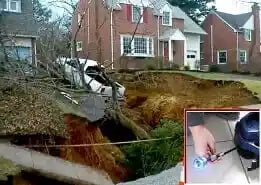As residents of Cheltenham, PA slept in the early morning hours of January 25, 2017, a 30-foot-wide sinkhole broke open in font of two homes.1 From poor drainage, wet conditions, and thousands of years of geology, the sinkhole opened quickly and swallowed a pickup truck, large tree, and portions of the sidewalk and road.1

Image: A large sinkhole in Cheltenham Township, Pennsylvania¹
Among the natural disasters that occur on earth, sinkholes are right at the top of the “most terrifying” list. They are not easily predictable, they break open quickly, and they can cause massive damage to anything built above them. Sinkholes occur when the rock below the surface is limestone, carbonate rock, salt beds, or any other rock that is easily dissolvable in water.2 Ground water dissolves the rock over time, and creates empty space underground while the surface remains unaffected and seemingly stable.2 The moment of drama occurs when the ground breaks open, usually quickly, and the sinkhole becomes fully realized, and by then, the damage is done.
There is no data on how many sinkholes open up per year in the United States, but the United States Geological Survey (USGS) estimates that sinkhole damages over the last 15 years have cost on average $300 million per year totaling $4.5 billion.2 Certain states like Pennsylvania (Florida, Texas, Alabama, Kentucky, and Tennessee) are more prone to these phenomena due to their unique ground rock makeup.2 Beyond their structure and monetary damages, sinkholes threaten the very safety of residents, employees and motorists. Road and bridge structural integrity are of the utmost concern in these states, and the Departments of Transportation (DOT) continually battle sinkhole damage to transportation infrastructure.
Daniel Wooddell, a Geotechnical Specialist for the Pennsylvania DOT, knows firsthand about sinkholes in his south-central PA district. “Sinkholes pop up usually after large amounts of rain, and it’s our job to inspect them and find the best course of action to get the hole and the damaged infrastructure repaired,” said Wooddell.
Before any repairing occurs, the sinkhole must be inspected and evaluated. “We have to look inside the sinkhole to assess its cavity walls and size to find the best way to fill it and repair it,” said Wooddell. “It can be much bigger inside than it appears on the surface, so we have to make sure it’s safe to repair to begin with.”
Inspection requires the DOT to look inside the sinkhole, so a pan-tilt-zoom (PTZ) inspection camera system with illumination is used to get a clear image of its interior. Wooddell uses the Wohler VIS 700 HD, a robust PTZ camera system he keeps in his DOT truck. “We have other sophisticated probes and measuring systems to assess sinkholes, but those assets can take 1-2 weeks to schedule out from headquarters. Having the Wohler product on hand is very helpful to make quick and strategic inspections to find out the next best step for filling and repairing the sinkholes.”

The Wohler VIS 700 HD has a waterproof, IP67-rated, detachable 1.5” camera head that suits such applications. With HD video and picture and recording, bright illumination, and PTZ capabilities, it is a reliable and available resource for Wooddell and his PA DOT team. “It’s great to have on hand and does what we need it to do.”
If sinkholes are problematic in your state, get a reliable and quick DOT inspection resource in the Wohler VIS 700 HD today. Readily available in stock. Contact Us today!
Sources
1 https://abcnews.go.com/US/30-foot-wide-sinkhole-swallows-front-yards-pennsylvania/story?id=45036983

